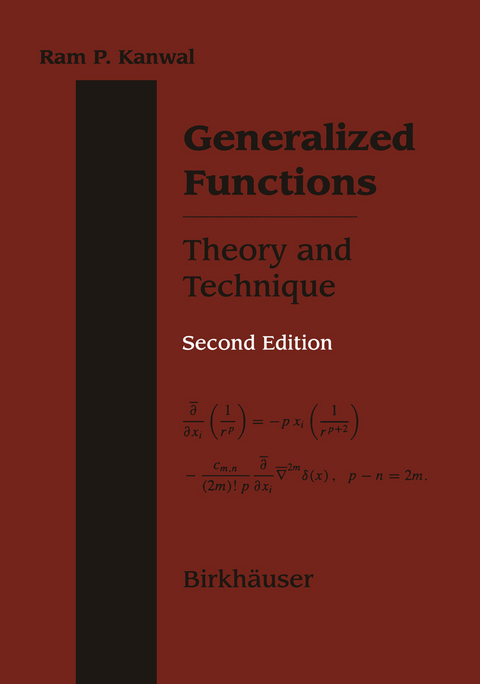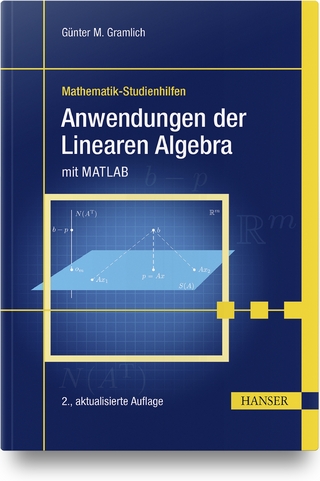
Generalized Functions Theory and Technique
Springer-Verlag New York Inc.
978-1-4684-0037-3 (ISBN)
- Lieferbar
- Versandkostenfrei
- Auch auf Rechnung
- Artikel merken
This second edition of Generalized Functions has been strengthened in many ways. The already extensive set of examples has been expanded. Since the publication of the first edition, there has been tremendous growth in the subject and I have attempted to incorporate some of these new concepts. Accordingly, almost all the chapters have been revised. The bibliography has been enlarged considerably. Some of the material has been reorganized. For example, Chapters 12 and 13 of the first edition have been consolidated into Chapter 12 of this edition by a judicious process of elimination and addition of the subject matter. The new Chapter 13 explains the interplay between the theories of moments, asymptotics, and singular perturbations. Similarly, some sections of Chapter 15 have been revised and included in earlier chapters to improve the logical flow of ideas. However, two sections are retained. The section dealing with the application of the probability theory has been revised, and I am thankful to Professor Z.L. Crvenkovic for her help. The new material included in this chapter pertains to the modern topics of periodic distributions and microlocal theory. I have demonstrated through various examples that familiarity with the generalized functions is very helpful for students in physical sciences and technology. For instance, the reader will realize from Chapter 6 how the generalized functions have revolutionized the Fourier analysis which is being used extensively in many fields of scientific activity.
1. The Dirac Delta Function and Delta Sequences.- 1.1. The heaviside function.- 1.2. The Dirac delta function.- 1.3. The delta sequences.- 1.4. A unit dipole.- 1.5. The heaviside sequences.- Exercises.- 2. The Schwartz-Sobolev Theory of distributions.- 2.1. Some introductory definitions.- 2.2. Test functions.- 2.3. Linear functionals and the Schwartz-Sobolev theory of distributions.- 2.4. Examples.- 2.5. Algebraic operations on distributions.- 2.6. Analytic operations on distributions.- 2.7. Examples.- 2.8. The support and singular support of a distribution.- Exercises.- 3. Additional Properties of Distributions.- 3.1. Transformation properties of the delta distribution.- 3.2. Convergence of distributions.- 3.3. Delta sequences with parametric dependence.- 3.4. Fourier series.- 3.5. Examples.- 3.6. The delta function as a Stieltjes integral.- Exercises.- 4. Distributions Defined by Divergent Integrals.- 4.1. Introduction.- 4.2. The pseudofunction H(x)/xn, n = 1, 2, 3,....- 4.3. Functions with algebraic singularity of order m.- 4.4. Examples.- Exercises.- 5. Distributional Derivatives of Functions with Jump Discontinuities.- 5.1. Distributional derivatives in R1.- 5.2. Moving surfaces of discontinuity in Rn, n ? 2.- 5.3. Surface distributions.- 5.4. Various other representations.- 5.5. First-order distributional derivatives.- 5.6. Second-order distributional derivatives.- 5.7. Higher-order distributional derivatives.- 5.8. The two-dimensional case.- 5.9. Examples.- 5.10. The function Pf(1/r) and its derivatives.- 6. Tempered Distributions and the Fourier Transform.- 6.1. Preliminary concepts.- 6.2. Distributions of slow growth (tempered distributions).- 6.3. The Fourier transform.- 6.4. Examples.- Exercises.- 7. Direct Products and Convolutions of Distributions.- 7.1.Definition of the direct product.- 7.2. The direct product of tempered distributions.- 7.3. The Fourier transform of the direct product of tempered distributions.- 7.4. The convolution.- 7.5. The role of convolution in the regularization of the distributions.- 7.6. The dual spaces E and E?.- 7.7. Examples.- 7.8. The Fourier transform of a convolution.- 7.9. Distributional solutions of integral equations.- Exercises.- 8. The Laplace Transform.- 8.1. A brief discussion of the classical results.- 8.2. The Laplace transform distributions.- 8.3. The Laplace transform of the distributional derivatives and vice versa.- 8.4. Examples.- Exercises.- 9. Applications to Ordinary Differential Equations.- 9.1. Ordinary differential operators.- 9.2. Homogeneous differential equations.- 9.3. Inhomogeneous differentational equations: the integral of a distribution.- 9.4. Examples.- 9.5. Fundamental solutions and Green’s functions.- 9.6. Second-order differential equations with constant coefficients.- 9.7. Eigenvalue problems.- 9.8. Second-order differential equations with variable coefficients.- 9.9. Fourth-order differential equations.- 9.10. Differential equations of nth order.- 9.11. Ordinary differential equations with singular coefficients.- Exercises.- 10. Applications to Partial Differential Equations.- 10.1. Introduction.- 10.2. Classical and generalized solutions.- 10.3. Fundamental solutions.- 10.4. The Cauchy-Riemann operator.- 10.5. The transport operator.- 10.6. The Laplace operator.- 10.7. The heat operator.- 10.8. The Schrödinger operator.- 10.9. The Helmholtz operator.- 10.10. The wave operator.- 10.11. The inhomogeneous wave equation.- 10.12. The Klein-Gordon operator.- Exercises.- 11. Applications to Boundary Value Problems.- 11.1. Poisson’s equation.- 11.2.Dumbbell-shaped bodies.- 11.3. Uniform axial distributions.- 11.4. Linear axial distributions.- 11.5. Parabolic axial distributions, n = 5.- 11.6. The fourth-order polynomial distribution, n = 7; spheroidal cavities.- 11.7. The polarization tensor for a spheroid.- 11.8. The virtual mass tensor for a spheroid.- 11.9. The electric and magnetic polarizability tensors.- 11.10. The distributional approach to scattering theory.- 11.11. Stokes flow.- 11.12. Displacement-type boundary value problems in elastostatistics.- 11.13. The extension to elastodynamics.- 11.14. Distributions on arbitrary lines.- 11.15. Distributions on plane curves.- 11.16. Distributions on a circular disk.- 12. Applications to Wave Propagation.- 12.1. Introduction.- 12.2. The wave equation.- 12.3. First-order hyperbolic systems.- 12.4. Aerodynamic sound generation.- 12.5. The Rankine-Hugoniot conditions.- 12.6. Wave fronts that carry infinite singularities.- 12.7. Kinematics of wavefronts.- 12.8. Derivation of the transport theorems for wave fronts.- 12.9. Propagation of wave fronts carrying multilayer densities.- 12.10. Generalized functions with support on the light cone.- 12.11. Examples.- 13. Interplay Between Generalized Functions and the Theory of Moments.- 13.1. The theory of moments.- 13.2. Asymptotic approximation of integrals.- 13.3. Applications to the singular perturbation theory.- 13.4. Applications to number theory.- 13.5. Distributional weight functions for orthogonal polynomials.- 13.6. Convolution type integral equation revisited.- 13.7. Further applications.- 14. Linear Systems.- 14.1. Operators.- 14.2. The step response.- 14.3. The impulse response.- 14.4. The response to an arbitrary input.- 14.5. Generalized functions as impulse response functions.- 14.6. The transfer function.- 14.7. Discrete-time systems.- 14.8. The sampling theorem.- 15. Miscellaneous Topics.- 15.1. Applications to probability and random processes.- 15.2. Applications to economics.- 15.3. Periodic distributions.- 15.4. Applications to microlocal theory.- References.
| Zusatzinfo | 474 p. |
|---|---|
| Verlagsort | New York, NY |
| Sprache | englisch |
| Maße | 178 x 254 mm |
| Themenwelt | Mathematik / Informatik ► Mathematik ► Algebra |
| Mathematik / Informatik ► Mathematik ► Analysis | |
| Mathematik / Informatik ► Mathematik ► Angewandte Mathematik | |
| ISBN-10 | 1-4684-0037-1 / 1468400371 |
| ISBN-13 | 978-1-4684-0037-3 / 9781468400373 |
| Zustand | Neuware |
| Haben Sie eine Frage zum Produkt? |
aus dem Bereich



